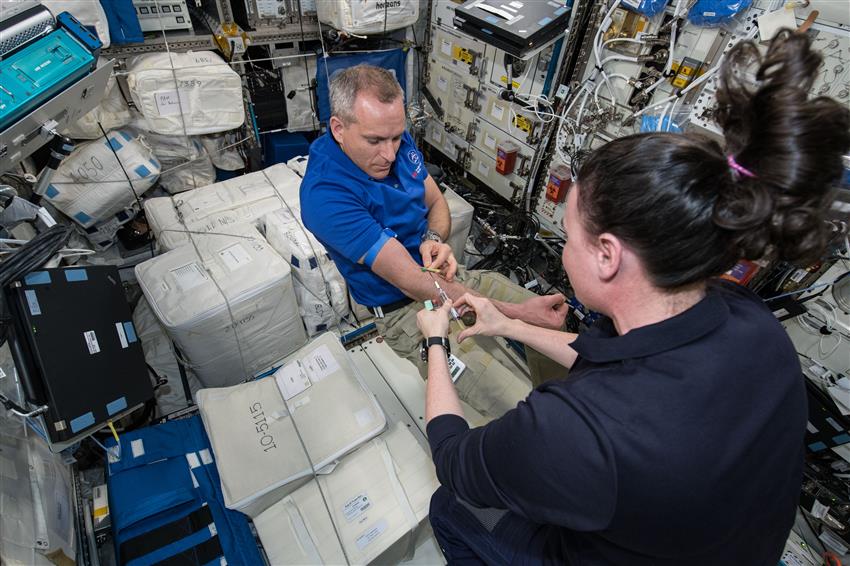Canadian ISS research could change how anemia is treated on Earth
Ground-breaking research aboard the International Space Station (ISS), supported by the Canadian Space Agency (CSA) and led by Dr. Guy Trudel, is bringing critical information to light that could lead to new treatments for patients who suffer from anemia.
"Our MARROW experiment points us toward a mechanism for why people who are weightless become anemic," said Dr. Trudel, a researcher at The Ottawa Hospital and University of Ottawa. "This finding has great potential for my clinical work as a rehabilitation physician because weightlessness and the inactivity that my patients experience have similar effects on the body."
The Canadian experiment MARROW, conducted on the International Space Station, studied how bone marrow (the spongy tissue inside bones) and the blood cells it produces change in space. The study produced interesting results that help us better understand space anemia. (Credits: Canadian Space Agency, NASA, The Ottawa Hospital/University of Ottawa)
Unlocking the secrets of space anemia
For decades, researchers have known that astronauts develop a condition called "space anemia." Until recently, the condition was thought to be caused by fluid shifts in the body as astronauts adapt to the near-weightless environment of the ISS. It was also thought to resolve after about 10 days in space.
But Dr. Trudel used highly sensitive equipment and a novel process to show that space anemia is not a temporary condition caused by fluid shifts. In fact, the findings pointed in an unsuspected direction.
Under normal conditions on Earth, healthy, active people create and destroy millions of red blood cells every second in a finely tuned balance. Dr. Trudel's measurements showed that astronauts who suffer from space anemia destroy 54 percent more red blood cells than normal throughout their six-month space flights – and for weeks or months after they return to Earth.
"We have determined that the space environment itself causes more red blood cell degradation than normal over a long period," said Dr. Trudel.
Applying his findings on Earth
In his clinical work at The Ottawa Hospital, Dr. Trudel rehabilitates patients who have been on bedrest or have been otherwise inactive. Typically, they suffer from anemia as a result. Anemia makes people feel tired and weak because their low levels of red blood cells cannot carry enough oxygen to their tissues.
As Dr. Trudel explains it, the weightlessness of space mimics the inactivity of being on bedrest on Earth because, in both situations, the body is not actively working against the force of gravity. Many health issues can result.
But knowing that these factors cause anemia is not enough to solve the problem. Dr. Trudel's detective work will now shift to discovering precisely what is causing astronauts' blood cells to be destroyed at such a high rate in space.
"We need to pinpoint the mechanism for the destruction of blood cells before we can develop preventative measures or treatments," he said. "If the mechanisms on Earth and in space are the same, we'll be able to use treatments in both contexts." Dr. Trudel has narrowed the potential causes to a likely mechanism involving either bone marrow or the spleen.
Part of a larger body of research
Dr. Trudel's MARROW study is closely related to CSA-funded work he is doing as part of a series of studies known as analogues. Analogue studies are conducted on Earth, but are designed to mimic the effects of other environments, such as space.
Dr. Trudel's participation in a bedrest analogue study conducted in Planica, Slovenia, will test his hypothesis that artificial gravity, combined with resistance exercises, will help reduce the number of red blood cells people lose when they are on bedrest. The results will help researchers understand how to protect the health of astronauts on long space flights. This valuable data is also likely to play a role in the future of space exploration, as crews venture farther from Earth.

